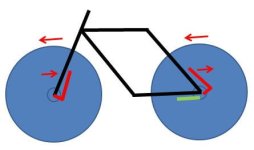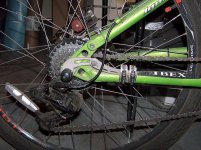ryan
10 kW
I'm in love with the power of 72V, but unfortunately it's making my dropouts beg for mercy. Can you point me in the right direction for how to get rear dropouts? I've included a few photos, but I'm not really sure what's necessary to either buy rear dropouts or have them custom fabricated.
In this photo you can see that the bolt has moved about 15*. (It should be pointed up toward the nub above it, pretty much 90* to the chainstay. Yes, I have my bolts cranked down HARD with a ratchet.
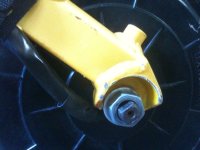
Here's the other side.

And here's what a dropout might look like.
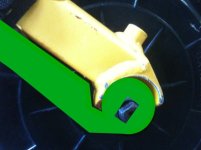
Are there vendors that have rear dropouts that would fit this? How would I go about determining if my frame would fit them?
If not, what measurements are important to give someone to have them fabricate a torque arm for me? Any pointers on how to do this? Or photos that would be important to take and diagram out?
Thanks.
(Until they're fabricated I'm staying very low on amp draw to minimize tension on the dropouts... they don't move at all if I'm gentle. It's only when I push it hard from a stop that makes me nervous.)
In this photo you can see that the bolt has moved about 15*. (It should be pointed up toward the nub above it, pretty much 90* to the chainstay. Yes, I have my bolts cranked down HARD with a ratchet.

Here's the other side.

And here's what a dropout might look like.

Are there vendors that have rear dropouts that would fit this? How would I go about determining if my frame would fit them?
If not, what measurements are important to give someone to have them fabricate a torque arm for me? Any pointers on how to do this? Or photos that would be important to take and diagram out?
Thanks.
(Until they're fabricated I'm staying very low on amp draw to minimize tension on the dropouts... they don't move at all if I'm gentle. It's only when I push it hard from a stop that makes me nervous.)


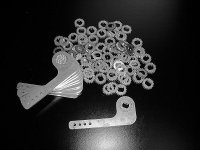
![IMGP4201 [Desktop Resolution].JPG IMGP4201 [Desktop Resolution].JPG](https://endless-sphere.com/sphere/data/attachments/20/20495-0853aa9926ba731dfbb01e5149424887.jpg)
![IMGP4202 [Desktop Resolution].JPG IMGP4202 [Desktop Resolution].JPG](https://endless-sphere.com/sphere/data/attachments/20/20496-9e48da3d18af965b10626f86d76f42df.jpg)


